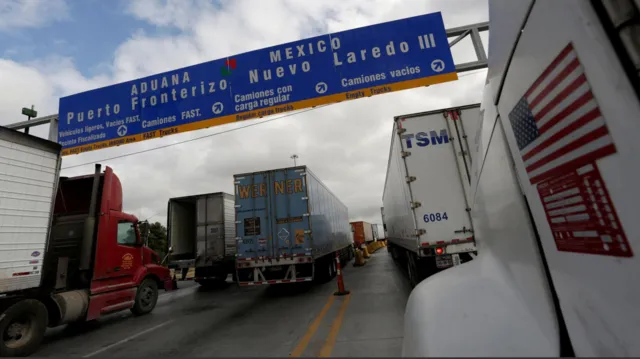Donald Trump says he will hit China, Mexico and Canada with new tariffs on day one of his presidency, in an effort to force them to crack down on illegal immigration and drug smuggling into the US.
The president-elect said that immediately after his inauguration on 20 January he will sign an executive order imposing a 25% tariff on all goods coming from Mexico and Canada.
He also said an additional 10% tariff will be levied on China until the government there blocks smuggling of the synthetic opioid fentanyl from the country.
If Trump follows through with the threats it will mark a major escalation in tensions with America’s three biggest trading partners.
The tariffs on Mexico and Canada will remain in place until the two countries clamp down on drugs, particularly fentanyl, and migrants illegally crossing the border, Trump said in a post on his Truth Social platform.
“Both Mexico and Canada have the absolute right and power to easily solve this long simmering problem,” he said.
“It is time for them to pay a very big price!”
In a separate post, Trump attacked Beijing for failing to follow through on promises he said Chinese officials made to carry out the death penalty for people caught dealing fentanyl.
A spokesperson for the Chinese embassy in Washington told the BBC “the idea of China knowingly allowing fentanyl precursors to flow into the United States runs completely counter to facts and reality”.
“China believes that China-US economic and trade cooperation is mutually beneficial in nature. No one will win a trade war or a tariff war,” he added.
The Biden administration has been calling on Beijing to do more to stop the production of ingredients used in fentanyl, which Washington estimates killed almost 75,000 Americans last year.
During his election campaign, Trump threatened Mexico and China with tariffs of up to 100%, if he deemed them necessary, much higher than those he put in place during his first term in office.
Trump has also said he will end China’s most-favoured-nation trading status with the US – the most advantageous terms Washington offers on tariffs and other restrictions.
Tariffs are a central part of Trump’s economic vision – he sees them as a way of growing the US economy, protecting jobs and raising tax revenue.
He has previously claimed that these taxes are “not going to be a cost to you, it’s a cost to another country”.
This is almost universally regarded by economists as misleading.
“It’s clearly consistent with his promise that he made during the campaign to utilise tariffs as a weapon to accomplish many of his policy initiatives,” Stephen Roach, Senior Fellow at the Paul Tsai China Center of Yale Law School told the BBC’s Business Today programme.
Trump’s pick for Treasury Secretary, Scott Bessent, has previously suggested that the president-elect’s threats to impose major tariff hikes were part of his negotiating strategy.
“My general view is that at the end of the day, he’s a free trader,” Bessent said of Trump in an interview with the Financial Times before he was nominated for the role.
“It’s escalate to de-escalate.”
It comes as the Chinese economy is in a significantly more vulnerable position than it was during the previous Trump presidency.
The country has been struggling with a number of serious issues, including an ongoing property market crisis, weak domestic demand and growing local government debt.
The new tariffs appear to break the terms of the US-Mexico-Canada Agreement (USMCA) on trade.
The deal, which Trump signed into law, took effect in 2020. It continued a largely duty-free trading relationship between the three neighbouring countries.
After Trump made his tariff threat, he discussed trade and border security with Canada’s Prime Minister Justin Trudeau, according to the Reuters news agency.
Mexico’s finance ministry said: “Mexico is the United States’ top trade partner, and the USMCA provides a framework of certainty for national and international investors.”





